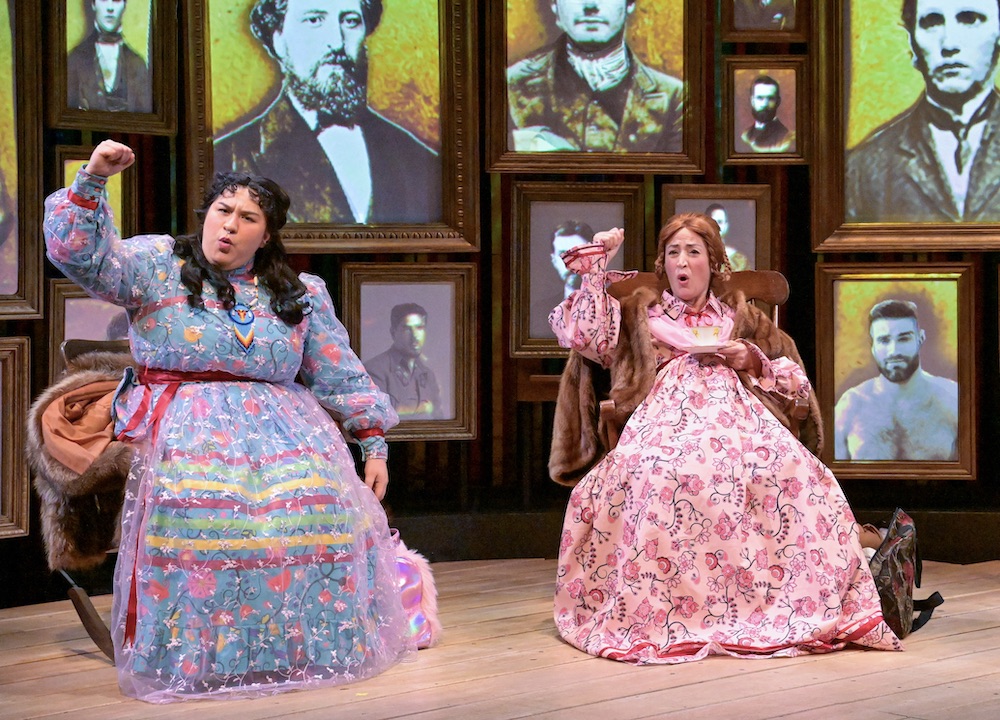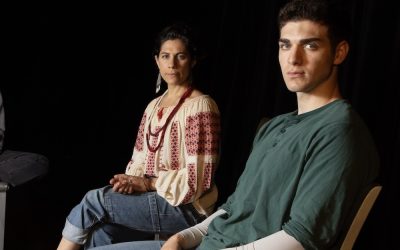One of these days, I hope to see a fully realized production of playwright Fraces Končan’s Women of the Fur Trade, a production that might allow me to see the script’s true potential — or lack thereof. This remount of the National Art’s Centre’s interpretation is not that production.
The direction is problematic and, although a couple of the performances work, others flat out do not.
Two very important caveats: I’m a white male critic talking about a piece of theatre that has largely been created by Indigenous women; and, stylistically, Končan’s script is as tricky as it is adventuresome.
Women of the Fur Trade is an absurdist satire. In “eighteen hundred and something something”, in a fort that is neither Manitoba’s Upper nor Lower Fort Garry, and that is on the Reddish rather than the Red River, three women rock in their rockers, drink imaginary tea, and talk.
Marie-Angelique, who’s Métis, is stanning Louis Riel something fierce. She dreams about becoming his bride, a desire that significantly ramps up her politics of resistance. Marie-Angelique’s friend Cecilia, who’s white, insists that she’s very, very proud of being married — although she’s clearly miserable — and delighted to accept the limitations of her subservient role as a woman. But Cecilia’s also got a crush on Riel’s Irish frenemy Thomas Scott. Scott acts as Riel’s secretary and spies on him for the Canada Party, which is fighting to rid the young nation of “the Indian problem.” Then there’s Eugenia: trapper, trader, defender of the land. Eugenia has no need for a husband — and no patience with colonial supervision.
Perhaps because she’s so in touch with the land, Eugenia can come and go from their little room, while the other two remain trapped, No Exit-like, in a limbo defined by the limits of racism and sexism, including Indigenous and female erasure.
Thematically ambitious, Končan’s writing is also joyously anachronistic. Within the first few minutes, these nineteenth-century women namedrop Andy Warhol, Tyra Banks, and The Kinks. And the writing is often funny: asked why she’s so consistently hot for “basic white boys”, Marie-Angelique replies, with a sense of wonder, “They’re just so confident — for no good reason!”
But much of the humour — and the emotional impact — of the show must be brought to life in performance by the players, and that’s where things get tricky. In February of this year, I attended the Firehall Arts Centre’s production of Women of the Fur Trade. In that mounting, there were some terrific characterizations — and some that missed the boat. (Here’s my review of that version.) As I said off the top, there are successful and unsuccessful portraits in this production too — but the successes and failures aren’t always in the same roles, so I’m sure it’s possible to get, at the very least, a more consistently successful production than the ones I’ve seen so far.
In this version of Women of the Fur Trade, Cheri Maracle, who is of Mohawk and Irish descent, is a standout as Cecilia, the white woman. Maracle knows how to play absurdity with absolute sincerity, in Cecilia’s knee-jerk response to trouble, for instance: “We should ask the men. They will know.” And, vocally, Maracle’s performance is fantastic: for comic spin and/or emotional impact, she plays the musicality of her range, sometimes dropping her pitch much lower than you’d expect.
Victor Hunter is also strong as Thomas Scott. He’s completely committed to the character’s paradoxically entitled, yet low-status, point of view. When Riel reams him out, saying, “I expected more from you, Thomas,” Hunter’s Scott replies with a wide-eyed, delighted, puppy-like “You did?” You can almost see his tail wagging.
In terms of characterizations, there are problems elsewhere, though.
Marie-Angelique occupies the centre of the text, and Kelsey Kanatan Wavey, who’s been cast in the role, overplays it relentlessly. Especially in Act 1, everything she does is loud, fast, and superficial. Emotionally, I didn’t buy the character for a minute, and the actor’s exhausting delivery made me long for the intermission.
Director Renae Morriseau must take her share of the responsibility for the issues with pace, depth, and variety, which affect not just this performance, but, to lesser degrees, all the performances.
Kanatan Wavey’s characterization improves in Act 2 — partly because she finally gets to play a fully dramatized, interactive scene (with Victor Hunter’s Thomas Scott), as opposed to negotiating the amorphousness of Act 1’s associativity.
The relative success of Act 2 makes me wonder about the ultimate viability of Act 1, even in a perfect production.
Back to characterizations. Performer Jonathan Fisher is trying hard as Louis Riel: under Morrisseau’s direction, he delivers a highly physicalized performance. But, again, nothing rings true — even in basic ways. When the three women imitate Riel, they speak with French Canadian accents, but, playing Riel, Fisher never does. Fisher isn’t up to the job and Morrisseau should not have cast him.
Columpa Bobb brings enormous stage experience to her portrait of Eugenia but, as written, the character, who is the play’s most articulate spokesperson for Indigenous resistance, is the least theatrically rewarding: she has no focused, concretely based conflicts with other characters, or even well-developed struggles within herself.
Pleasingly, set designer Lauchlin Johnston flanks his raised wooden playing area with curtains made of ribbons, paying tribute, no doubt, to ribbon skirts. And costumer Vanessa Imeson gives Marie-Angelique a particularly pretty dress, complete with ribbons on the turquoise patterned skirt and a delicately gauzy overskirt.
Until I see a more fully realized production of Women of the Fur Trade, my sense of the script’s potential will remain hazy.
In this less than perfect production, Act 2 works better than Act 1, but Act 1 feels long and sets the bar low.
WOMEN OF THE FUR TRADE by Frances Končan. Directed by Renae Morrisseau. A National Arts Centre, Great Canadian Theatre Company, and Native Earth production. Presented by Touchstone Theatre in association with Western Canada Theatre and UBC Theatre and Film. At the Frederic Wood Theatre until October 4. Tickets
PHOTO CREDIT: (Photo of Kelsey Kanatan Wavey and Cheri Maracle by Fred Cattrall. Set by Lauchlin Johnston. Costumes by Vanessa Imeson)
THERE’S MORE! You can get all my current reviews PLUS curated local, national, and international arts coverage in your inbox FREE every week if you subscribe to Fresh Sheet, the Newsletter. Just click that link. (Unsubscribe at any time. Super easy. No hard feelings.) Check it out.






0 Comments